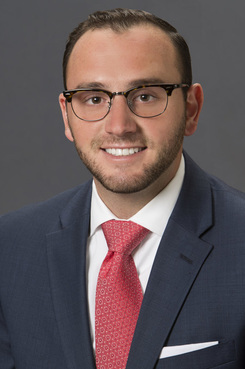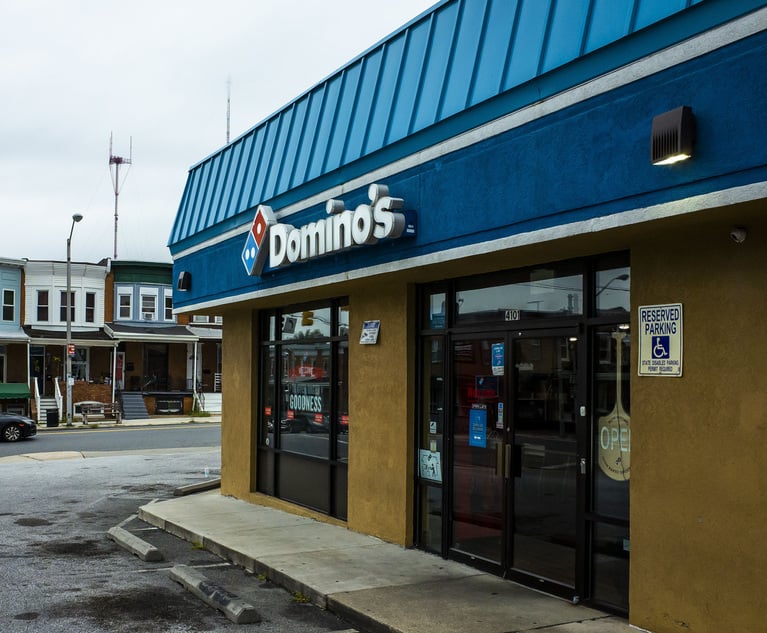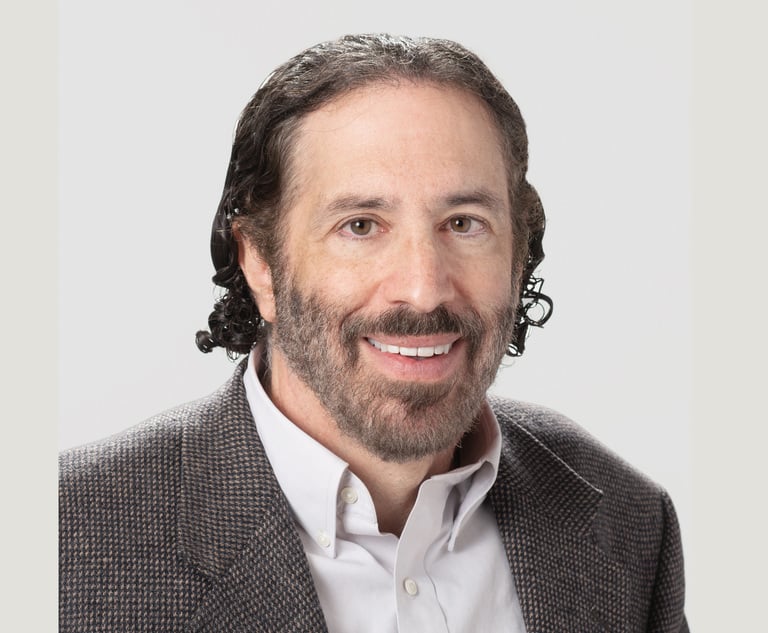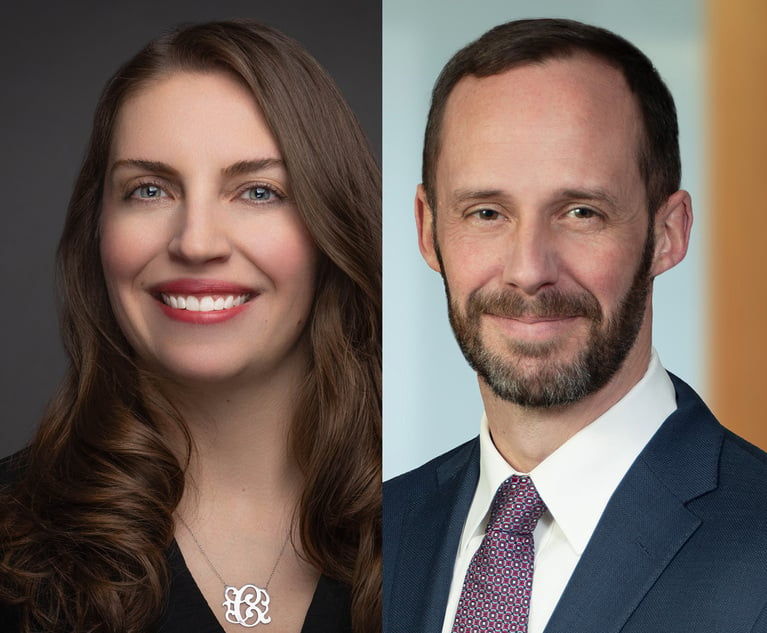The Ineffective Common Law Right to Privacy in Workers' Comp Claims
It is well understood that all individuals have an interest in privacy, but in the context of workers' compensation, that privacy right often succumbs to an employer's legitimate business interest
May 24, 2018 at 02:52 PM
10 minute read
 Taylor J. Cohen of Pond Lehocky Giordano Stern.
Taylor J. Cohen of Pond Lehocky Giordano Stern.
It is well understood that all individuals have an interest in privacy, but in the context of workers' compensation, that privacy right often succumbs to an employer's legitimate business interest, see Pamela V. Keller, “Balancing Employer Business Interests and Employee Privacy Interests: A Survey of Kansas Intrusion on Seclusion Cases in the Employment Context,” 61 U. Kan. L. Rev. 983 (2013). Employers and their insurance carriers, in efforts to protect themselves from frivolous claims, monitor injured workers using intricate image-enhancing technology, as in Moses v. McWilliams, 549 A.2d 950 (Pa. Super. Ct. 1988). While it is understood that employers have a legitimate business interest in protection from fraud and malingering, one of the weapons at their disposal, surreptitious surveillance, has stretched this effort too far.
Differing from other judicial proceedings, workers' compensation judges (WCJs) are not bound by common law or statutory rules of evidence in litigation. The evidentiary record usually consists of the injured worker's testimony, the testimony of an employer's fact witness, medical expert testimony, and demonstrative evidence, including surreptitious surveillance. This surveillance is admitted into the evidentiary record so long as it is the claimant depicted therein, and is reviewed to determine the credibility of the claim, either contradicting or confirming the medical testimony. As a result, surveillance serves as a crucial piece of evidence.
When conducted, surreptitious surveillance implicates the common law right to privacy, and therefore, is generally analyzed under common law privacy principles, see Moses v. McWilliams, 549 A.2d 950 (Pa. Super. Ct. 1988); Robert G. Boehmer, “Artificial Monitoring and Surveillance of Employees: The Fine Line Dividing the Prudently Managed Enterprise from the Modern Sweatshop,” 41 DePaul L. Rev. 739, 801 (1992). In most states, privacy law in tort takes four distinct forms: intrusion into private affairs; public disclosure of private facts; presentation in a false light; and appropriation of name or likeness, see Pauline T. Kim, “Privacy Rights, Public Policy, and the Employment Relationship,” 57 Ohio St. L.J. 671, 688 (1996); William L. Prosser, Privacy, 48 Cal. L. Rev. 383, 389 (1960). Only the first—intrusion into private affairs—is implicated by the quandary of surreptitious surveillance in workers' compensation claims.
To establish an intrusion upon seclusion, one must prove: an intrusion; the intrusion was intentional; the intrusion was upon the plaintiff's solitude or seclusion, or his private affairs or concerns; and the intrusion would be highly offensive to a reasonable person. An employer, therefore, risks intrusion upon seclusion tort liability when surveillance intrudes into private places where employees engage in primarily personal activities,” or when “monitoring activity is aimed at the employee's personal or private affairs.”
Under the current law, it is understood that a workers' compensation claimant has voluntarily placed himself in the public spotlight by filing a claim when injured on the job. However, such a notion is hard to rationalize when considering claimants do not voluntarily allow themselves to get hurt. Moreover, while the employer is entitled to perform a reasonable investigation of the alleged claim, such investigation has grown unreasonable as the “lawful vantage point” and “highly offensive to a reasonable person” elements have essentially negated an injured worker's ability to use the intrusion upon seclusion tort to protect their privacy.
The “lawful vantage point” theory allows employers to view anything that would be in the plain view from a lawful vantage point, see Daniel P. O'Gorman, “Looking Out for Your Employees: Employers' Surreptitious Physical Surveillance of Employees and the Tort of Invasion of Privacy,” 85 Neb. L. Rev. 212, 280 (2006). This test, as it has been implemented, substantially tips the scales in the employer's favor as the pertinent question is whether the investigator could have viewed the employee from a lawful vantage point, not whether the investigator was at a lawful vantage point. Moreover, liability does not attach when an employer intentionally “intrudes upon a claimant's seclusion” absent such intrusion being “highly offensive to the reasonable person.” An intrusion is highly offensive only when it is a substantial intrusion and the result of conduct which a reasonable person would strongly object. An explicit balancing of interests is necessary, therefore, to determine whether the intrusion is one that would be highly offensive to a reasonable person (i.e., the business interest must be sufficient to justify the invasion).
Currently, there is very little deterrent against the use of surveillance as the potential for tort liability of an employer or insurer for the hired investigator's conduct is minimal. Moreover, the standard applied to public conduct further diminishes a claimant's ability to litigate a violation of their right to privacy in the workers' compensation context. In most instances of public intrusion, courts adhere to the principle that what occurs in public cannot be private. Courts also continue to define “public space” to include “any place whether publicly or privately owned, to which the public has access.” Accordingly, it seems the only way to avoid voluntary exposure to unwarranted scrutiny would be to refrain from being in public (e.g., refrain from holding a job, going to the grocery store, obtaining medical help, taking a child to school, or going to a place of worship).
Furthermore, the surveillance is often a distorted view of the claimant and difficult to put in the context of the individual's daily life and activity, as it is common for the video to be shown out of context in attempting to disprove the workers' compensation claim. For example, surveillance will depict an individual with grocery bags, but not specify the contents therein (i.e., a loaf of bread versus a bag of dog food). Additionally, a lot of times the surveillance paints a picture of an active individual who is constantly coming and going from their home; however, the surveillance does not show where the individual is coming from or going to (e.g., attending a doctor's appointment related to their work injury).
Moreover, suffering a work injury should not be synonymous with a loss of life's privileges as such is not a damage one can collect in a workers' compensation proceeding. While the injured worker bears the burden of establishing their right to benefits, this burden does not include showing a complete debilitation. An injured worker should not feel compelled to show they are tethered to their bed, completely unable to function in society. Rather, the injured worker must prove they sustained an injury in the course and scope of their employment, notice was provided to the employer, the existence of a disability, and a causal connection between such disability and the injury (i.e., on-the-job injury and incapability of returning to work because they are unable to perform the requirements of their job). As such, an individual leaving their home, driving their car, or running errands, should not defeat a claim.
Furthermore, individuals hired to conduct surveillance often cross boundaries without regard for the individual's right to privacy. For example, a hired private investigator followed one of my firm's clients into a place of worship, videoing her as she sang in her church choir. There are also times when the surveillance is not restricted to the injured worker, but contains images/video of friends and family, including children. It is understood the employer loses the right to rely on the lawful-vantage-point concept if they engage in conduct to obtain a view that could not ordinarily be had from a lawful vantage point (i.e., taking unusual action to circumvent a barrier precluding observation), and proponents of the lawful vantage point believe this is the necessary limit, providing adequate protections for privacy claims. However, when considering technological advancements, this limitation is not providing adequate protection.
Moreover, employers have begun using more sophisticated, high-tech methods to monitor employee behavior. As modern technology has expanded the range of available supervisory tools, the determination of whether a matter of information is private or public has become increasingly difficult. For example, in Tagouma v. Investigative Consultant Services, 2010 PA Super 147, 4 A.3d 170 (2010), the claimant did not establish his right to privacy, as required to assert an invasion of privacy cause of action for intrusion upon seclusion against the company, even when the private investigator used vision-enhanced photographic equipment to videotape the claimant worshiping in the Islamic Center. The court explained the investigator was standing at a lawful vantage point in a parking lot across the street from the Islamic Center and his use of a zoom lens was not unreasonable.
The line between permissible and impermissible surveillance is rather gray in workers' compensation claims because the claimant's medical condition and physical activities are at issue. A countervailing business need, such as defending a legal claim, legitimizes conducting surveillance of employees outside the workplace. Furthermore, courts find surveillance lawful as the workers' compensation claimant should have realized their privacy was at risk because they filed a claim prompting the employer to conduct surveillance. However, such has gone too far. For example, in a 2010 case, a claimant unsuccessfully sued a private investigator for breach of privacy, after the investigator filmed him praying at a roadside mosque. There, the court explained that the mosque was open to the public and the claimant “was praying directly in front of a plate glass window.” The court also noted that “a workers' compensation claimant has a diminished expectation of privacy.”
“Privacy is inextricably tied to the idea of human dignity, of respect for the person, of the development and maintenance of a sense of self.” In an environment where surveillance is increasingly implicated by the filing of a workers' compensation claim, “pragmatism rather than legislative fiat seems the better approach, especially if, as many experts agree, there still is no clear definition of what privacy means.” Determination of the admissibility of surreptitious surveillance in workers' compensation proceedings is entirely within the discretion of the WCJ. Moving forward, WCJs should truly balance the respective rights and interests of the parties to determine whether an employer has invaded an employee's privacy. Accordingly, WCJs should first determine if the investigation invaded a private matter or information and then determine whether the employer's business need justified the scope of the intrusion and the means used, giving sufficient weight to the use of advanced technology.
While employers clearly have the right to monitor employee behavior, that right should not be limitless. Accordingly, courts must shift their interpretation of the “lawful vantage point” and “highly offensive to the ordinary reasonable person” elements of an intrusion upon seclusion claim. The use of surreptitious surveillance is a necessary evil of the workers' compensation arena; however, as technology continues to advance becoming more readily available, courts should consider the use of such technology a strong contributing factor of an intrusion upon seclusion. The above suggestions still provide employers the opportunity to conduct surveillance to protect against fraud and malingering; however, they hopefully begin to strike an updated balance between the injured worker's privacy rights and the employer's interest in conducting surveillance.
Taylor J. Cohen, an associate at Pond Lehocky Stern Giordano is a workers' compensation attorney. Contact him at [email protected].
This content has been archived. It is available through our partners, LexisNexis® and Bloomberg Law.
To view this content, please continue to their sites.
Not a Lexis Subscriber?
Subscribe Now
Not a Bloomberg Law Subscriber?
Subscribe Now
NOT FOR REPRINT
© 2025 ALM Global, LLC, All Rights Reserved. Request academic re-use from www.copyright.com. All other uses, submit a request to [email protected]. For more information visit Asset & Logo Licensing.
You Might Like
View All
Pa. Superior Court Rules Pizza Chain Liable for Franchisee Driver's Crash
4 minute read
Patent Pending ... and Pending ... and Pending? Brace Yourself for Longer Waits
3 minute read
Boosting Litigation and Employee Benefits Practices, Two Am Law 100 Firms Grow in Pittsburgh
3 minute read
Harrisburg Jury Hands Up $1.5M Verdict to Teen Struck by Underinsured Driver
3 minute readTrending Stories
- 1Rejuvenation of a Sharp Employer Non-Compete Tool: Delaware Supreme Court Reinvigorates the Employee Choice Doctrine
- 2Mastering Litigation in New York’s Commercial Division Part V, Leave It to the Experts: Expert Discovery in the New York Commercial Division
- 3GOP-Led SEC Tightens Control Over Enforcement Investigations, Lawyers Say
- 4Transgender Care Fight Targets More Adults as Georgia, Other States Weigh Laws
- 5Roundup Special Master's Report Recommends Lead Counsel Get $0 in Common Benefit Fees
Who Got The Work
J. Brugh Lower of Gibbons has entered an appearance for industrial equipment supplier Devco Corporation in a pending trademark infringement lawsuit. The suit, accusing the defendant of selling knock-off Graco products, was filed Dec. 18 in New Jersey District Court by Rivkin Radler on behalf of Graco Inc. and Graco Minnesota. The case, assigned to U.S. District Judge Zahid N. Quraishi, is 3:24-cv-11294, Graco Inc. et al v. Devco Corporation.
Who Got The Work
Rebecca Maller-Stein and Kent A. Yalowitz of Arnold & Porter Kaye Scholer have entered their appearances for Hanaco Venture Capital and its executives, Lior Prosor and David Frankel, in a pending securities lawsuit. The action, filed on Dec. 24 in New York Southern District Court by Zell, Aron & Co. on behalf of Goldeneye Advisors, accuses the defendants of negligently and fraudulently managing the plaintiff's $1 million investment. The case, assigned to U.S. District Judge Vernon S. Broderick, is 1:24-cv-09918, Goldeneye Advisors, LLC v. Hanaco Venture Capital, Ltd. et al.
Who Got The Work
Attorneys from A&O Shearman has stepped in as defense counsel for Toronto-Dominion Bank and other defendants in a pending securities class action. The suit, filed Dec. 11 in New York Southern District Court by Bleichmar Fonti & Auld, accuses the defendants of concealing the bank's 'pervasive' deficiencies in regards to its compliance with the Bank Secrecy Act and the quality of its anti-money laundering controls. The case, assigned to U.S. District Judge Arun Subramanian, is 1:24-cv-09445, Gonzalez v. The Toronto-Dominion Bank et al.
Who Got The Work
Crown Castle International, a Pennsylvania company providing shared communications infrastructure, has turned to Luke D. Wolf of Gordon Rees Scully Mansukhani to fend off a pending breach-of-contract lawsuit. The court action, filed Nov. 25 in Michigan Eastern District Court by Hooper Hathaway PC on behalf of The Town Residences LLC, accuses Crown Castle of failing to transfer approximately $30,000 in utility payments from T-Mobile in breach of a roof-top lease and assignment agreement. The case, assigned to U.S. District Judge Susan K. Declercq, is 2:24-cv-13131, The Town Residences LLC v. T-Mobile US, Inc. et al.
Who Got The Work
Wilfred P. Coronato and Daniel M. Schwartz of McCarter & English have stepped in as defense counsel to Electrolux Home Products Inc. in a pending product liability lawsuit. The court action, filed Nov. 26 in New York Eastern District Court by Poulos Lopiccolo PC and Nagel Rice LLP on behalf of David Stern, alleges that the defendant's refrigerators’ drawers and shelving repeatedly break and fall apart within months after purchase. The case, assigned to U.S. District Judge Joan M. Azrack, is 2:24-cv-08204, Stern v. Electrolux Home Products, Inc.
Featured Firms
Law Offices of Gary Martin Hays & Associates, P.C.
(470) 294-1674
Law Offices of Mark E. Salomone
(857) 444-6468
Smith & Hassler
(713) 739-1250





